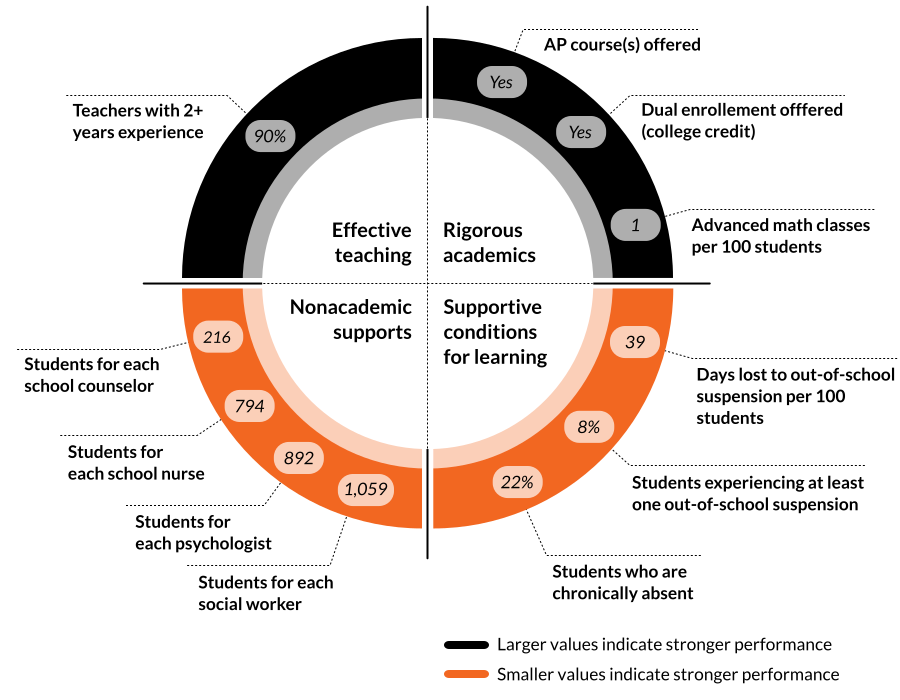Baltimore City’s population peaked in the early 1950s, but suburbanization and deindustrialization have since led to steady population decline. The Great Migration and White flight shifted the city’s racial demographics from majority-White to majority-Black by the mid-1970s. Baltimore City schools began desegregating in 1956, but these efforts have been dampened by persistent neighborhood segregation.
In 1950, Detroit was the fifth-largest U.S. city, and its economy relied heavily on the auto industry. In the latter half of the 20th century, relocation of automobile factories to the suburbs, and eventually overseas, led to population decline and unemployment. Housing and employment discrimination have contributed to persistent residential segregation. Detroit has been a majority-Black city since the 1970s; currently, nearly 80 percent of residents are Black. Over one third of Detroit residents live below the poverty line. Detroit public school enrollment has fallen and over half of students now attend charter schools, which may be outside of their neighborhoods.
Washington DC was the nation’s first city with a majority-Black population. Until 1948, the Supreme Court allowed lower courts to enforce racial covenants that prevented Black families from buying properties in White neighborhoods. In the 1950s, urban renewal in DC’s Southwest quadrant displaced thousands of Black residents and businesses. Many moved to the far Southeast quadrant, where large areas were rezoned for rental apartments and public housing. After the enactment of the 1968 Fair Housing Act and the riots sparked by the assassination of Martin Luther King, Jr., many Black families left DC for the suburbs. Washington’s population has been increasing recently, but much of this growth has been in middle- and upper-class neighborhoods. Almost half of DC students attend charter schools, which may be outside of their neighborhoods.
Los Angeles is the second-largest city in the United States. From 1942 to 1964, the Bracero program brought millions of people from Mexico to work on farms and railroads in California. Due to redlining, restrictive covenants, and discrimination, most Black residents lived in South Central Los Angeles prior to the 1970s, and most Mexican residents lived in East Los Angeles. Although neighborhood segregation has decreased, this pattern remains. In Los Angeles County, nearly 1 in 4 people live in poverty.
Philadelphia’s population peaked in 1950, followed by decline until 2008. From around 1950 to 1990, the city lost many of its manufacturing jobs. At the same time, the Black and Puerto Rican population grew, while White residents moved to racially restricted suburbs. From 1990 to 2010, the city’s White population fell from 52 percent to 37 percent, while the Asian and Hispanic populations more than doubled.
Since the Great Migration, Chicago’s Black population has been concentrated in the South and West sides of the city. After World War II, urban renewal projects displaced many Black and poor Chicagoans, exacerbating severe housing shortages. Many White residents followed manufacturing jobs to the suburbs. Recently, the city’s White population has been increasing as the Black population has declined.
Neighborhood segregation in Omaha mirrors the boundaries of a Home Ownership Loan Corporation map drawn in the 1930s. Black families mainly live in North Omaha, with Latino families (largely Mexican) primarily in South Omaha and White families largely in the western suburbs. From 1975 to 1999, Omaha Public Schools (OPS) implemented government-mandated busing to comply with school desegregation, and OPS enrollment sharply declined. In 2007, Omaha adopted a learning community bill, allowing students to attend any school in 11 neighboring districts if it would improve the school’s socioeconomic diversity.
In 1928, a consulting firm proposed a city zoning plan for Austin that would segregate Black families, who lived throughout the city, into a new “Negro District” across East Avenue (now Interstate 35). Latino residents of Austin were legally classified as White but were not considered White by many residents and realtors, and faced discrimination in the private housing market as a result. To this day, most Black or Mexican Austin residents live east of I-35. The construction of I-35 and the Urban Revitalization Program further isolated East Austin by destroying housing and limiting residents’ mobility. Since 2000, East Austin has seen an increase in residents with higher incomes, as many residents with lower incomes have been displaced (i.e., gentrification).
In 1935, Atlanta built the first public housing project in the United States. Through discriminatory policies, many Black families were segregated into overcrowded neighborhoods, including public housing projects, in southern Atlanta. Subsequently, Atlanta was also the first city to receive a HOPE VI grant to demolish projects to reduce concentrated poverty. While many Black residents have recently moved to surrounding suburbs, many of the neighborhoods they live in and the schools they attend remain segregated. Since the 1970s, Atlanta has been a majority-Black city, but the majority of population and job growth has occurred in the northern part of the city and its suburbs, which remain majority-White.
In the early 1900s, many Black families from the Bahamas settled in Miami. By the 1950s, most Black residents lived in Overtown, Liberty City, Brownsville, and Opa-locka. After the Cuban Revolution, U.S. immigration policy helped many Cuban families move to Miami; these new residents primarily settled in Little Havana. In the early 1990s, Miami became a majority-Latino city. The construction of Interstate 95 and urban renewal displaced about 10,000 Overtown residents. Due to longstanding residential segregation, Miami-Dade County Public Schools remain segregated.



